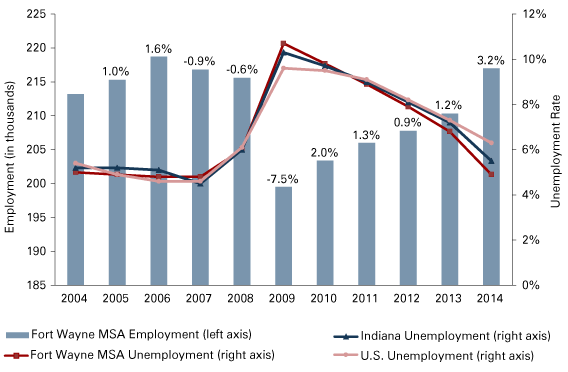Fort Wayne Forecast 2015
Director, Community Research Institute, Indiana University–Purdue University Fort Wayne
Labor force dynamics in 2014 have brought continued improvements to Metro Fort Wayne (Allen, Whitley and Wells counties). Fort Wayne’s labor force grew by 2.9 percent between August 2013 and August 2014 (+6,036), compared to 1.7 percent growth statewide, with more rapid growth occurring within its employed segment (see Table 1).
Table 1: Labor Force Dynamics
| August | Labor Force | Employed | Unemployed | |||
|---|---|---|---|---|---|---|
| Fort Wayne MSA | Indiana | Fort Wayne MSA | Indiana | Fort Wayne MSA | Indiana | |
| 2004 | 210,281 | 3,175,566 | 199,695 | 3,010,515 | 10,586 | 165,051 |
| 2005 | 213,797 | 3,223,917 | 203,304 | 3,054,916 | 10,493 | 169,001 |
| 2006 | 217,855 | 3,255,512 | 207,291 | 3,090,673 | 10,564 | 164,839 |
| 2007 | 213,374 | 3,228,578 | 203,051 | 3,082,008 | 10,323 | 146,570 |
| 2008 | 215,041 | 3,267,312 | 202,158 | 3,069,863 | 12,883 | 197,449 |
| 2009 | 209,812 | 3,192,701 | 187,419 | 2,864,155 | 22,393 | 328,546 |
| 2010 | 210,469 | 3,185,787 | 189,738 | 2,876,136 | 20,731 | 309,651 |
| 2011 | 208,846 | 3,186,349 | 190,289 | 2,898,812 | 18,557 | 287,537 |
| 2012 | 205,929 | 3,166,240 | 189,670 | 2,908,832 | 16,259 | 257,408 |
| 2013 | 206,754 | 3,190,560 | 192,606 | 2,959,470 | 14,148 | 231,090 |
| 2014 | 212,790 | 3,245,079 | 202,282 | 3,067,111 | 10,508 | 177,968 |
| Change: 2006-14 | -2.3% | -0.3% | -2.4% | -0.8% | -0.5% | 8.0% |
| Change: 2013-14 | 2.9% | 1.7% | 5.0% | 3.6% | -25.7% | -23.0% |
Source: U.S. Bureau of Labor Statistics (not seasonally adjusted)
Continuing a four-year trend, the metro area’s unemployment rate (4.9 percent) remains well below that for the state (5.5 percent) and the nation (6.3 percent), as shown in Figure 1.1 However, the metro area’s labor force remains 2.3 percent below (-5,065) its pre-recession peak in 2006. Fort Wayne will likely surpass this benchmark in 2015.
Figure 1: August Employment Growth and Unemployment

Note: Percentages denote year-over-year employment growth.
Source: U.S. Bureau of Labor Statistics (not seasonally adjusted)
Metro Fort Wayne’s employment growth surged ahead in 2014 adding 6,700 new jobs (see Figure 1). This represents the strongest one-year change in the last decade at 3.2 percent. Fort Wayne employment (217,000) remains just 1,700 below its pre-recession peak in 2006 (218,700).
Meanwhile, Indiana has surpassed its 2006 employment, adding 48,700 jobs to Indiana’s economy. Growth has been concentrated within the Indianapolis, Columbus and Lafayette metro areas (see Table 2).
Table 2: Employment Change by Metro Area
| August 2014 | August 2006 | Numeric Change | Percent Change | |
|---|---|---|---|---|
| Columbus | 50,800 | 44,600 | 6,200 | 14% |
| Lafayette | 96,800 | 90,500 | 6,300 | 7% |
| Indianapolis | 966,100 | 905,600 | 60,500 | 7% |
| Indiana | 3,006,900 | 2,958,200 | 48,700 | 2% |
| Muncie | 51,000 | 51,100 | -100 | 0% |
| Gary | 273,600 | 275,200 | -1,600 | -1% |
| Evansville | 178,000 | 179,300 | -1,300 | -1% |
| Fort Wayne | 217,000 | 218,700 | -1,700 | -1% |
| Terre Haute | 70,900 | 72,200 | -1,300 | -2% |
| Anderson | 41,600 | 42,500 | -900 | -2% |
| Bloomington | 79,000 | 81,200 | -2,200 | -3% |
| Kokomo | 46,100 | 47,900 | -1,800 | -4% |
| Elkhart-Goshen | 125,400 | 133,200 | -7,800 | -6% |
| South Bend | 133,800 | 143,600 | -9,800 | -7% |
| Michigan City–La Porte | 41,700 | 46,600 | -4,900 | -11% |
Note: These data are preliminary.
Source: U.S. Bureau of Labor Statistics (not seasonally adjusted)
Manufacturing and health care continue to serve as cornerstones for job growth in metro Fort Wayne. Of the 6,700 new jobs in the region, 2,800 jobs were added in professional and business services and 2,200 in manufacturing (see Table 3).
Table 3: Employment by Industry
| Industry | Fort Wayne MSA | Indiana | ||||
|---|---|---|---|---|---|---|
| August 2014 | August 2013 | Numeric Change | Percent Change | Numeric Change | Percent Change | |
| Total | 217,000 | 210,300 | 6,700 | 3.2% | 60,400 | 2.0% |
| Professional and Business Services (includes temp services) | 23,400 | 20,600 | 2,800 | 13.6% | 7,100 | 2.3% |
| Manufacturing | 36,700 | 34,500 | 2,200 | 6.4% | 20,100 | 4.1% |
| Private Educational and Health Services | 37,900 | 36,900 | 1,000 | 2.7% | 5,200 | 1.2% |
| Other Services | 11,200 | 10,400 | 800 | 7.7% | 5,100 | 4.3% |
| Transportation, Warehousing and Utilities | 9,500 | 9,300 | 200 | 2.2% | 2,200 | 1.6% |
| Leisure and Hospitality | 20,300 | 20,100 | 200 | 1.0% | 8,800 | 2.9% |
| Information | 3,200 | 3,200 | 0 | 0.0% | -700 | -1.9% |
| Financial Activities | 11,800 | 11,800 | 0 | 0.0% | 2,100 | 1.6% |
| Government (includes public schools and hospitals) | 20,700 | 20,700 | 0 | 0.0% | 3,500 | 0.9% |
| Retail Trade | 21,900 | 22,000 | -100 | -0.5% | -2,800 | -0.9% |
| Natural Resources, Mining and Construction | 9,700 | 9,900 | -200 | -2.0% | 7,100 | 5.2% |
| Wholesale Trade | 10,700 | 10,900 | -200 | -1.8% | 2,700 | 2.3% |
Note: Table is sorted by MSA numeric change.
Source: U.S. Bureau of Labor Statistics (not seasonally adjusted)
An examination of more granular quarterly data reveals that Fort Wayne has registered strong growth in temporary employment services, a subsector within professional and business services. The feedback from workforce development partners suggests that a large proportion of the temp workers are employed with regional manufacturers. Continued diversification and growth in other high-wage sectors remains a long-term challenge for the region.
Looking Ahead to 2015
We expect job growth of about 2 percent in 2015. Issues like health care reform, demand for durable goods, the state budget and interest rates will continue to play important roles in Fort Wayne’s economic performance. As the labor market continues to tighten, this will put wage pressures on employers in order to find the workers they need. However, if employers are unwilling or unable to raise wages, disengaged workers may not find the incentive they need to re-enter the labor force. While unemployment rates may be driven further down in 2015, they will likely remain in the 4.0 percent to 5.0 percent range.




